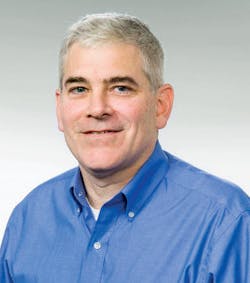Hybrid beamforming enables 5G at millimeter-wave range
As 5G standards are realized, the goals for higher data rates, lower-latency network access, and more energy-efficient implementations are clear, according to Rick Gentile, product manager, Phased Array System Toolbox and Signal Processing Toolbox, MathWorks. “How do you build a cost-effective system that achieves all of these goals?” he asks. “We know that higher data rates drive the need for greater bandwidth spectrums, which moves operating frequency bands up into the millimeter-wave range. This creates new challenges in understanding complexities in the propagation channels. We also know that all of the subsystems, from the antenna, through the RF chain, to signal processing, have to be active parts of the system-level solution. These subsystems each contain design ‘knobs’ that can be tuned together to meet system design goals.” In an email Q&A, he elaborates on hybrid beamforming and its applicability to the implementation of mmWave 5G technology.
First, could you briefly describe hybrid beamforming—what are its benefits at mmWave frequencies, and why can’t we use the same techniques as are used below 6 GHz?
Hybrid beamforming makes use of both analog beamforming and digital precoding techniques to intelligently form the patterns transmitted from a large antenna array. The same technique is used on the receive side to create a desired received pattern. This could be to emphasize where patterns are focused spatially to strengthen what signal is processed. It also helps to reduce the impact of undesired signals.
The driver for hybrid beamforming is more the result of the presence of a large number of antenna array elements. We see very large arrays at the mmWave frequencies. The large arrays drive the need to find ways to implement practical designs, which is where hybrid beamforming comes into play.
Hybrid beamforming requires partitioning between RF and digital domains. As the industry stands today, is hybrid beamforming a necessary technique? If not, at what point will it become a crucial component in the design process?
If cost and power were not constrained in 5G systems, dedicated receive and transmit paths could be added for each MIMO array element. This type of architecture would provide the most flexibility from a system-level standpoint, to form beams in high-multiuser scenarios.
In reality, hybrid beamforming is a crucial design component because resources are limited. From a system standpoint, the balance comes in finding the optimal partitioning between how RF and digital beamforming is implemented. The good news is that this partitioning is possible. You can build a system with less than a 1:1 mapping between the MIMO array elements and the Tx/Rx signal chains and still achieve the flexibility needed to satisfy a multiuser scenario.
When modeling a system array, what are the main design factors to consider? How do these considerations vary between typical array designs and millimeter-wave designs?
One of the advantages of moving to millimeter wave is that antenna element sizes scale with wavelength. This enables a very large number of elements in a reasonable physical size. More elements and more RF connections for each element add complexity. The array design has to allow for MIMO operations to support spatial multiplexing, in order to meet the higher channel capacity requirements. These all increase complexity because more hardware and software are needed. With the large numbers of array elements in a MIMO array, the design must also account for issues around mutual coupling between antenna elements.
What about MATLAB makes it suitable for designing millimeter-wave system arrays?
As we have discussed, designing millimeter-wave system arrays involves several challenges: First, standards are evolving, which drives the need for the maximum amount of flexibility in the development process. Multiple disciplines and areas of expertise are needed to build 5G systems. This drives the need for a development platform that helps with all aspects rather than just a subset of the system.
MATLAB provides a flexible platform for all aspects of the 5G design. Add-on products, such as Antenna Toolbox, Phased Array System Toolbox, and RF Blockset, make it easy to design antenna elements, design arrays, and design the RF signal chains. MATLAB provides a strong platform for designing, evaluating, and implementing signal-processing algorithms. MATLAB also makes it very easy to add, modify, and customize any portion of the system. This broad
diversity across the wireless signal chain is also matched on the workflow side. This includes everything from prototyping to implementation.
At what points in the design process do MATLAB and Simulink play the biggest roles? Is one better suited for a certain domain, or is the process more linear—first starting with MATLAB?
MATLAB provides a flexible platform to explore algorithms and build system models before any hardware is developed. The workflow covers everything from prototyping through implementation, including HDL- and C-code generation. The designs also cover a wide range of engineering domains. Antenna design, RF design, and signal processing all require specific domain expertise.
Large development teams see value because all engineers on the project get a voice at the design table. Without this type of modeling architecture in place, the different disciplines don’t come together until it is too late. With MATLAB and Simulink, the teams can work closely at all phases of the project. This approach improves communications on the team. It also helps teams find problems earlier in the design cycle, where they are less costly to correct.
Small teams find value because each member of the team may not be an expert in every part of the system design. Having tools that are easy to use and get started with makes it easier for small teams (with many fewer engineers) to cover the broad spectrum of system design.
And what is the role of Simulink?
Simulink feeds directly into the same value proposition. Engineers use Simulink to perform system-level architecture tradeoffs and multidomain RF/digital system simulations. Simulink also serves as an excellent platform for an “executable” specification for the system under development. Each engineer on the team can bring his or her design into a common model. For example, instead of producing a paper design, the RF engineer can build up a signal chain that can be used in a Simulink model directly with models for all of the other portions of the system. With these designs connected in a system-level model, changes from each team member can be evaluated as they are made. Simulink also makes it easy to take advantage of downstream workflow tools—for example, HDL- and C-code generation. This helps save time moving from prototypes to fielded systems by eliminating rework between project phases.
What are the main optimization techniques for improving beam-pattern configuration?
MATLAB and Simulink provide workflows that help to synthesize arrays to give a desired performance level. For example, this could mean generating weights, phase shifts, or even element positions through optimization techniques. This greatly reduces the time required when compared with manual techniques that are trial-and-error based.
What, if any, are the drawbacks of these techniques? What are the benefits?
The challenge is to come up with the proper cost function to guide the optimization. It is also important to identify any design constraints and account for them in the optimization process. The alternative approach is trial-and-error, which is time-consuming and does not adapt easily to change. This type of optimization workflow could also be extended to help with design partitioning between the RF and digital domains, which is part of the hybrid beamforming design process.
What are the main design and/or product constraints for system outputs? How are they best mitigated?
The main output of the hybrid beamforming design process is an architecture that is properly partitioned between the RF and digital domains. It also must include the precoding weights and RF phase shifts to meet the goal of improving the virtual connection between the base station and the user equipment (UE). The purpose of a multi-element array is to form multiple connections with many users in a coverage area.
The hybrid beamforming approach allows coarse-level steering using RF phase shifts. The digital precoding portion of the architecture enables very fine control steering to ensure the best channel.
All of the multiuser scenarios also assume a channel has been characterized. These channels are complex and have to be part of the overall design and thus are important aspects of the model. MATLAB and Simulink also make it easy to start with off-the-shelf channel models and to extend or customize any aspect of this type of model.
When assessing link-level performance, are signal-processing algorithms a necessary step in the process? What setup scenarios and algorithms enable the most optimal solutions?
A MIMO array enables a range of spatial-processing capabilities. Signal-processing algorithms including direction of arrival estimation, beamforming, and spatial multiplexing all make the application possible. This also includes the algorithms to help characterize the channel between the base station and the UE.
Including the full set of system components in the system model is important to optimize a link-level system. Understanding how design choices affect BER, spectral efficiency, and channel capacity before systems are fabricated is critical. Going back to an earlier point, it is important to have the option to perform signal processing where it is the most effective. Having a model for each portion of the system makes system design easier. Ideas can be tried at the lowest cost point in the project life cycle.
What are the main benefits of multiuser beamforming systems? How does this add to the complexity of the system’s architecture?
One of the goals of 5G is to increase capacity in terms of data rate between a base station and user equipment. The number of users connecting to a base station will also greatly increase. MIMO architectures enable multiuser systems by enabling spatial multiplexing. MIMO architectures are more complex because so many virtual connections are created between the base station and the UEs. This means more waveforms and more complex signal processing.
In your opinion, what is the No. 1 benefit of incorporating modeling and simulation techniques into 5G designs and hybrid-beamforming systems?
It is hard to pick one. We have seen teams benefit from improved communications across disciplines. We see teams benefit from discovering problems before hardware is built. System architects and designers also benefit from using MATLAB and Simulink by not having to start from scratch on algorithms and tools for antenna, array, and RF design and analysis. This helps to accelerate the phases of the projects, from prototyping through implementation. We see teams, large and small, that greatly benefit from the flexibility of the MATLAB platform and the related signal-processing simulation architecture. Developers also appreciate the option to integrate with the add-on products Communication System Toolbox and LTE System Toolbox and the related 5G Library.
Editor’s Note: For more information visit mathworks.com/solutions/wireless-communications.
About the Author

Rick Nelson
Contributing Editor
Rick is currently Contributing Technical Editor. He was Executive Editor for EE in 2011-2018. Previously he served on several publications, including EDN and Vision Systems Design, and has received awards for signed editorials from the American Society of Business Publication Editors. He began as a design engineer at General Electric and Litton Industries and earned a BSEE degree from Penn State.

